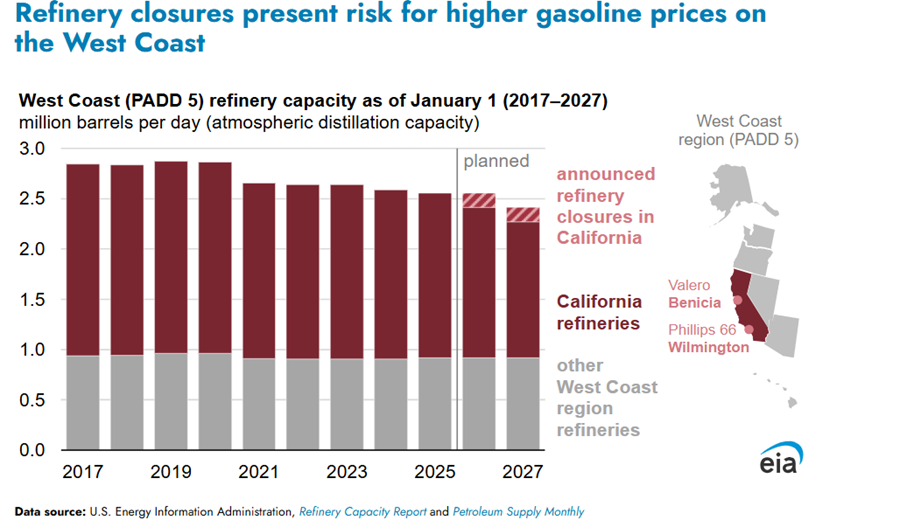DOE: U.S. crude oil inventories unexpectedly rose by 7.1 million barrels to 426 million in the week ending July 4, despite forecasts predicting a drawdown. The increase included a 1.8 million barrels per day adjustment for "unaccounted for crude oil," used by the EIA to balance supply data. Gasoline stocks dropped by 2.7 million barrels, nearly twice what was expected, as strong driving demand pushed consumption up 6% to 9.2 million bpd ahead of the July 4 holiday. Analysts, including Phil Flynn, interpreted the crude build as a likely one-time occurrence given the rebound in fuel demand. Meanwhile, distillate inventories fell by 825,000 barrels, refinery runs dipped slightly, and utilization rates declined to 94.7%.
Red Sea: Six crew members were rescued from the Red Sea on Wednesday, while 15 remain missing after the Eternity C cargo ship sank following repeated Houthi attacks. Four of the 25 crew were confirmed dead, marking the first fatalities in Red Sea shipping attacks since June 2024, while the rescued had spent over 24 hours in the water. The Houthis claimed responsibility for sinking the Eternity C and said they had also attacked another ship, the Magic Seas, which sank after its crew was safely rescued. These incidents mark a renewed campaign by Yemen's Iran-aligned Houthi militia, who had paused attacks earlier this year after targeting over 100 ships between November 2023 and December 2024 in solidarity with Palestinians. Both vessels flew Liberian flags and were operated by Greek firms, with some of their sister ships previously docking at Israeli ports, possibly making them targets. The attacks have led to a drop in Red Sea shipping traffic and a rise in oil prices, while international shipping groups have condemned the violence and called for stronger protection of maritime routes.
OPEC+: OPEC has lowered its global oil demand forecasts for the next four years due to slowing economic growth in China. Despite this, it raised its long-term demand outlook, citing increased consumption in developing countries and no signs of peak oil use. OPEC+, which includes Russia, is boosting production to regain market share, but lower medium-term demand may complicate plans to fully reverse earlier output cuts. OPEC now expects world oil demand to reach 106.3 million barrels per day in 2026 and 111.6 million in 2029. These figures are lower than last year’s estimates, with the 2029 forecast cut by 700,000 barrels per day.
Market Overview: Oil prices edged lower on Thursday, with U.S. West Texas Intermediate (WTI) crude falling 62 cents, or 0.9%, to $67.76 a barrel, as investors weighed the economic risks of new tariffs proposed by President Donald Trump. The tariffs, targeting countries like Brazil, South Korea, and Japan, as well as industries such as copper and semiconductors, raised concerns about inflation and slower global growth, which could dampen oil demand. Despite this, market reactions were muted due to Trump’s inconsistent tariff policy, prompting a cautious "wait and see" stance from traders. Supporting oil prices was a weaker U.S. dollar, which makes oil cheaper for foreign buyers, along with rising gasoline demand and record global flight activity in early July. However, doubts remain about whether OPEC+’s announced production increases will materialize, as some members face output constraints or are already exceeding their quotas.

California is expected to lose 17% of its oil refinery capacity over the next year due to the planned closures of the Phillips 66 Wilmington refinery and the Valero Benicia refinery. These closures continue a trend of shrinking West Coast refining capacity, following previous shutdowns at Phillips 66’s Rodeo and Marathon’s Martinez refineries. While these facilities represent less than 2% of U.S. capacity, they account for a significant portion of California's and the broader West Coast's capacity, making the region especially vulnerable to supply disruptions. Limited pipeline and logistical connections to other U.S. refinery hubs, such as the Gulf Coast, mean the shortfall is unlikely to be filled domestically. As a result, California and neighboring states like Arizona and Nevada may increasingly rely on fuel imports from Asia, particularly those that meet California’s strict CARBOB fuel specifications. Gasoline imports into the West Coast have already reached record highs in May 2025 and are expected to rise further once the refinery closures take effect.

Oil prices fell around 2% on Thursday, with U.S. West Texas Intermediate (WTI) crude dropping $1.81, or 2.72%, to $66.57 per barrel, as markets reacted to the potential economic impact of new U.S. tariffs. President Trump threatened Brazil with a 50% tariff on exports, prompting Brazilian President Lula to consider retaliatory measures. Trump also announced tariffs targeting copper, semiconductors, and pharmaceuticals, and sent notices to countries including the Philippines, Iraq, South Korea, and Japan. Despite the announcements, markets showed limited reaction due to Trump’s history of inconsistent tariff enforcement, with analysts describing investor sentiment as cautious. Concerns over inflation and high interest rates, combined with OPEC+ plans to boost oil production in September, also weighed on oil prices.
